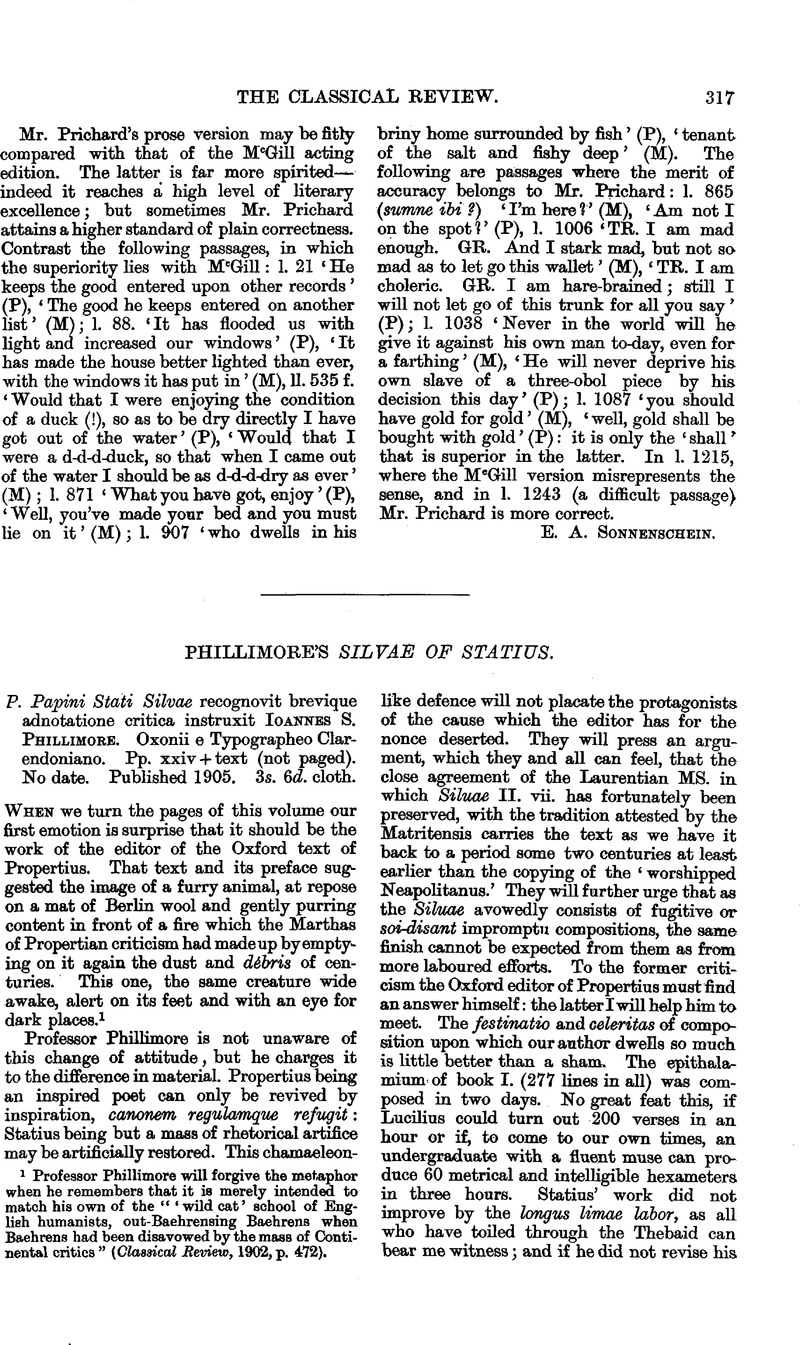No CrossRef data available.
Published online by Cambridge University Press: 27 October 2009

page 317 note 1 Professor Phillimore will forgive the metaphor when he remembers that it is merely intended to match his own of the “‘wild cat’ school of English humanists, out-Baehrensing Baehrens when Baehrens had been disavowed by the mass of Continental critics” (Classical Review, 1902, p. 472).
page 318 note 2 C.R. xvii. pp. 344 sqq.
page 319 note 1 In n. 2 on p. xiii. we read ‘ Klotz, Vollmer, Krohn lacunam a semet ipsis factam oranimodis caementis atque sordibus explore certant.’ The first part of this sentence begs the question and the second part, which is an echo of Dr. Engelmann, is irrelevant, as I have already shown (C. R. I.e. p. 348). ‘ He must apply himself to a supplement which Statius might have written, not to those which could by no possibility be his.’
page 319 note 2 Let me here protest against the assigning of this text to me alone, as is done by Mr. Phillimore (‘editio—Postgatiana,’ p. xxi) and Mr.Slater, (Journal of Philology, xxx. p. 144)Google Scholar. It is fair neither to Mr. Davies nor to myself. The character the joint editorship is clearly set forth in the preface to the fourth part of the Corpus, p. xi. It joint in the sense that both of us contributed to the text, not in the sense that either singly is responsible for a particular reading in it.
I would at the same time with the aid of Mr. Phillimore's apparatus correct some wrong ascriptions of conjectures which escaped us. I. ii. 183 the punctuation is Herr Helm's (1900); iv. 85 quantas Markland; II. iii. 69 quo Baehrens (on this see below); IV. ii. 6 dominamque dedit contingere mensam Waller; ib. 83 uisus (an early emender, see below); V. iii1. 269 Heinsius, teste Mr. Housman (C.R. Feb. 1906, p. 47), conjectured a lacuna here.
page 320 note 1 A is to be carefully distinguished from A*. These arereadings which are safeguarded by a note from Politian that they are taken from the Vetus, and to them the remarks in the text do not apply.
page 320 note 2 Another correction of mine cui pateat V. iii. 183 is made unintelligible by the omission of cui.
page 321 note 1 If he did not, the correction is hardly his. It not uncommon for this to happen. At IV. iii. 19 both Ellis and Riese have proposed clauum; but first in the sense of ‘nail’ and the second in that of ‘tiller.’ One of these clauum's is wrong, but Mr. Phillimore does not tell us which he takes.
page 323 note 1 I take the opportunity of ackowledging this scholar'sfair and courteous review of the Corpus text in Wölfflin's Archiv. for 1905.
Its tone is in marked contrast to that of another notice which appeared in the Berliner Philologische Wochenschrift about which I might say something.
But it is not worth while, as Lucretius iii. 388–390 ‘ nec repentis itum cuiusuiscumque animantis | sentimus nec priua pedum uestigia quaeque | Corpore quae in nostro culices et cetera ponunt’ has already expressed my sentiments.